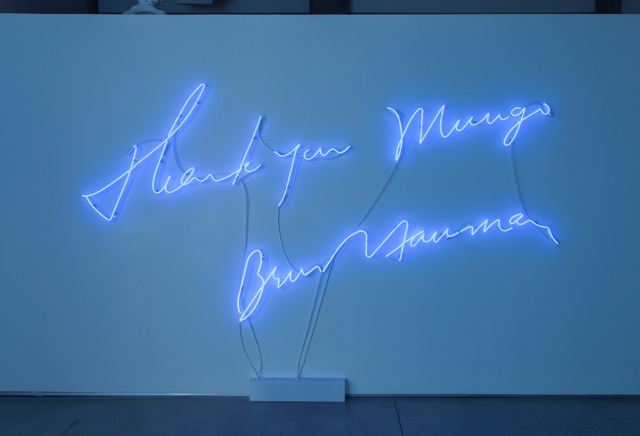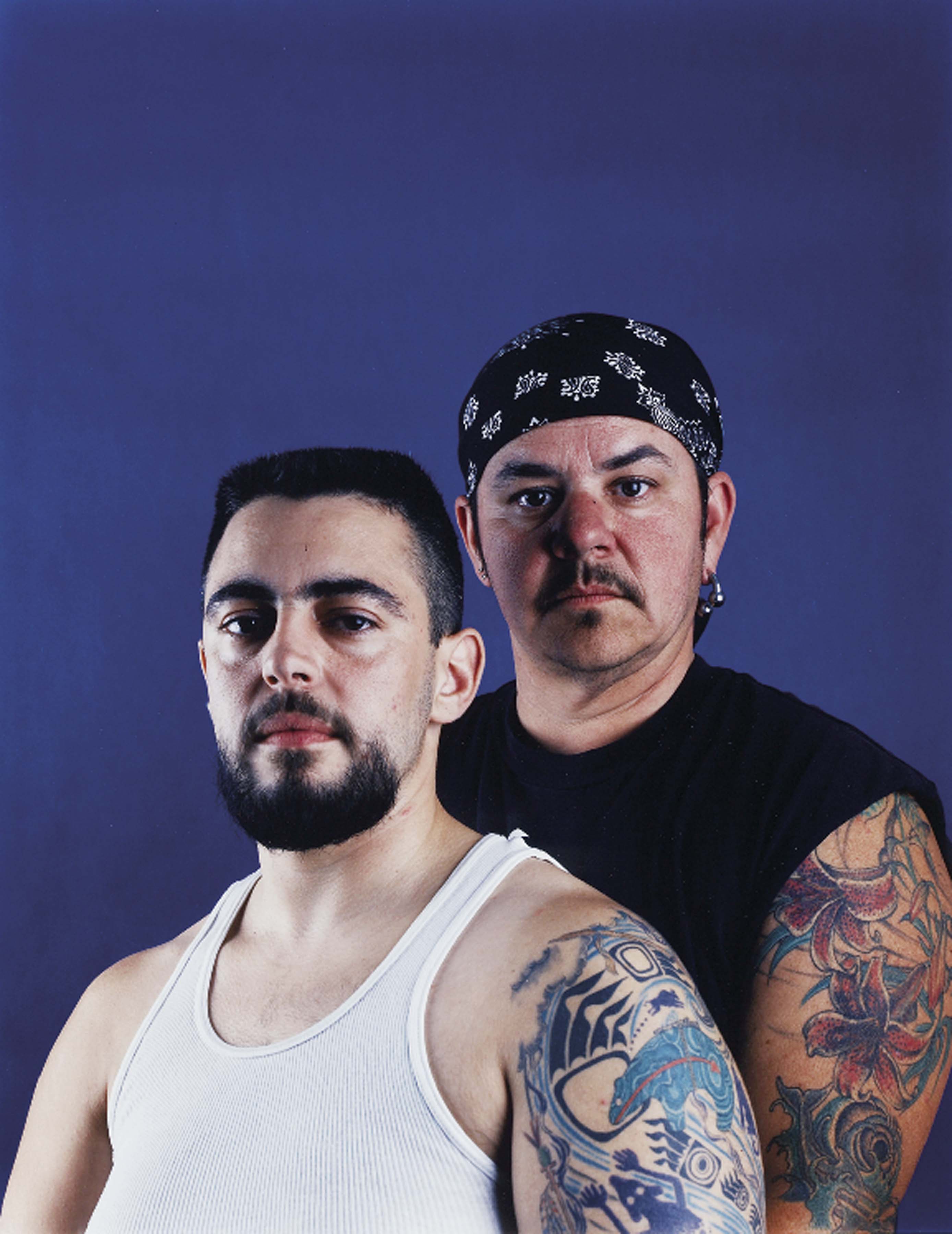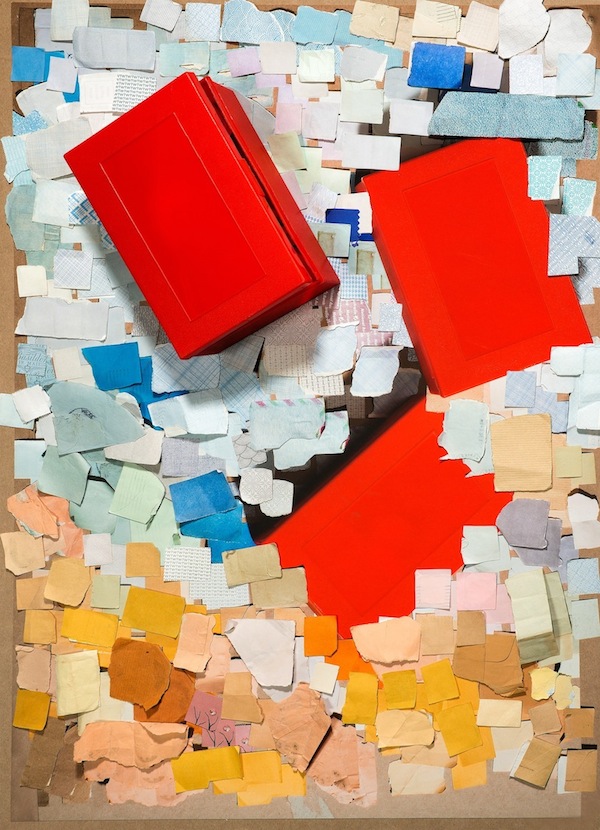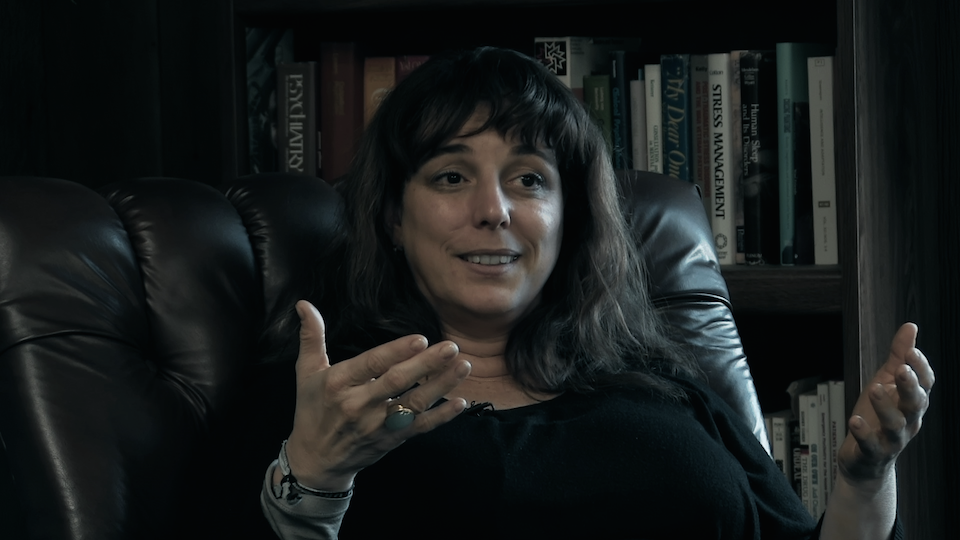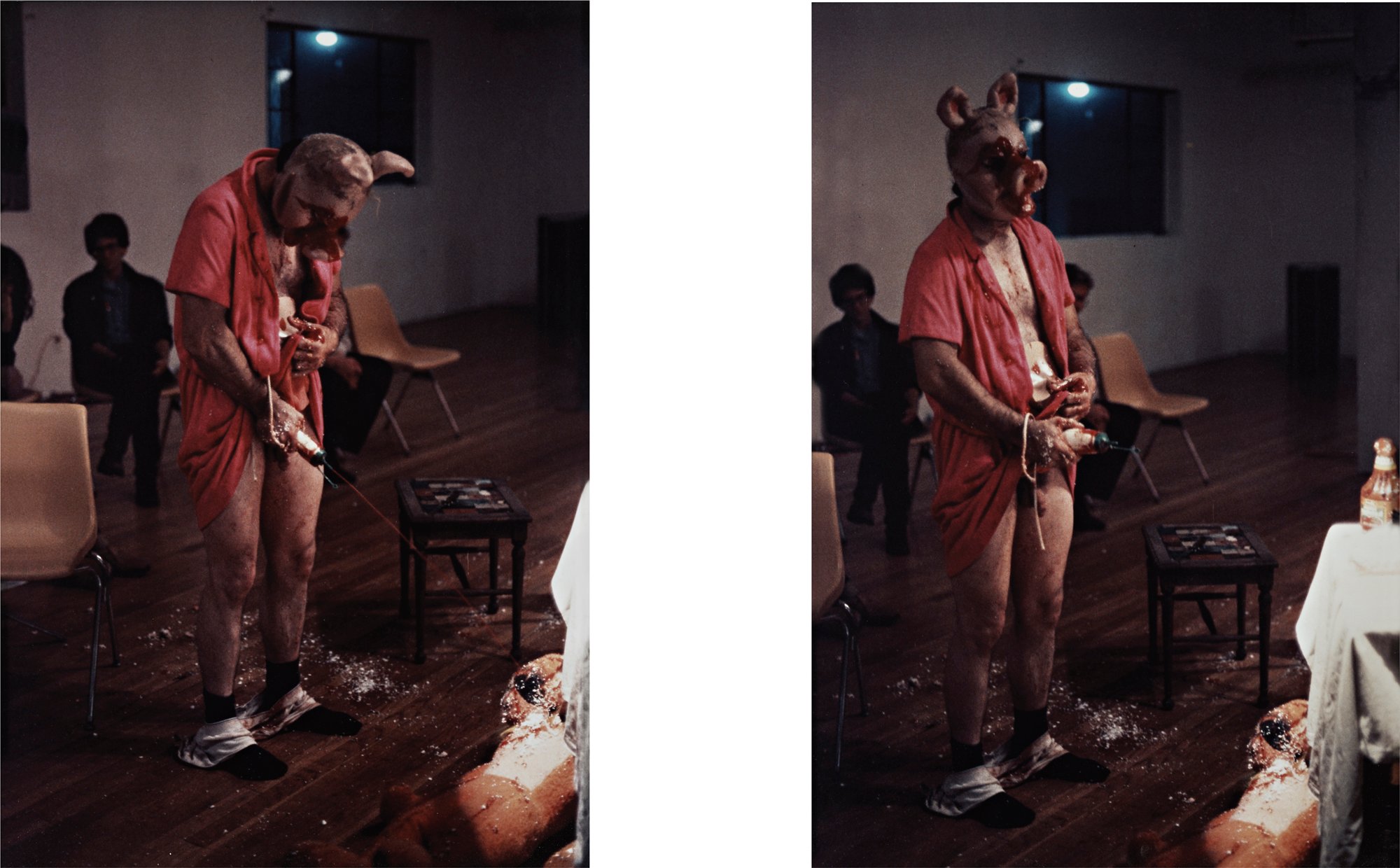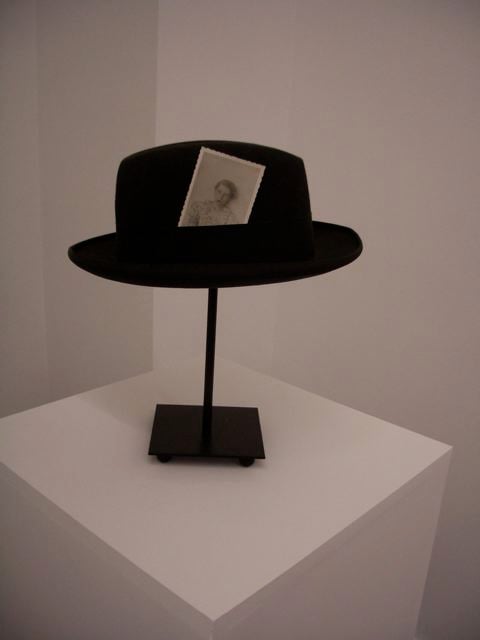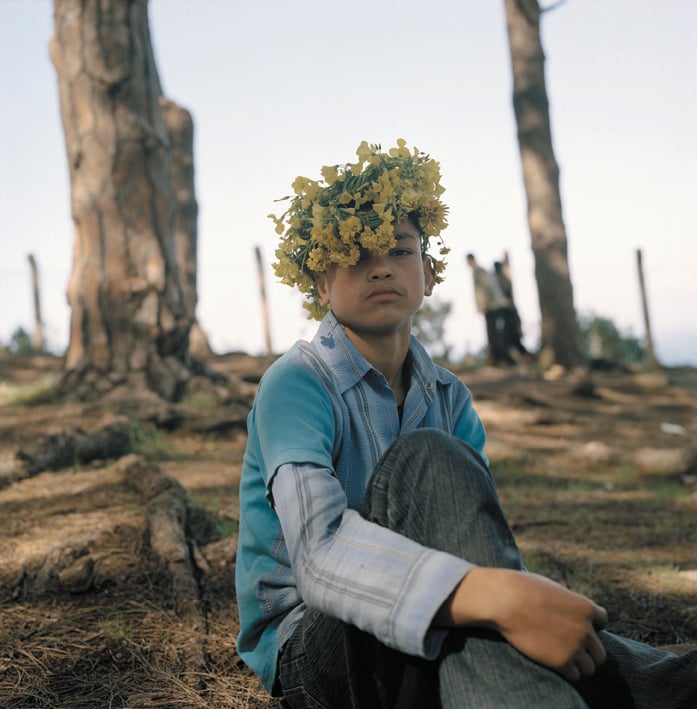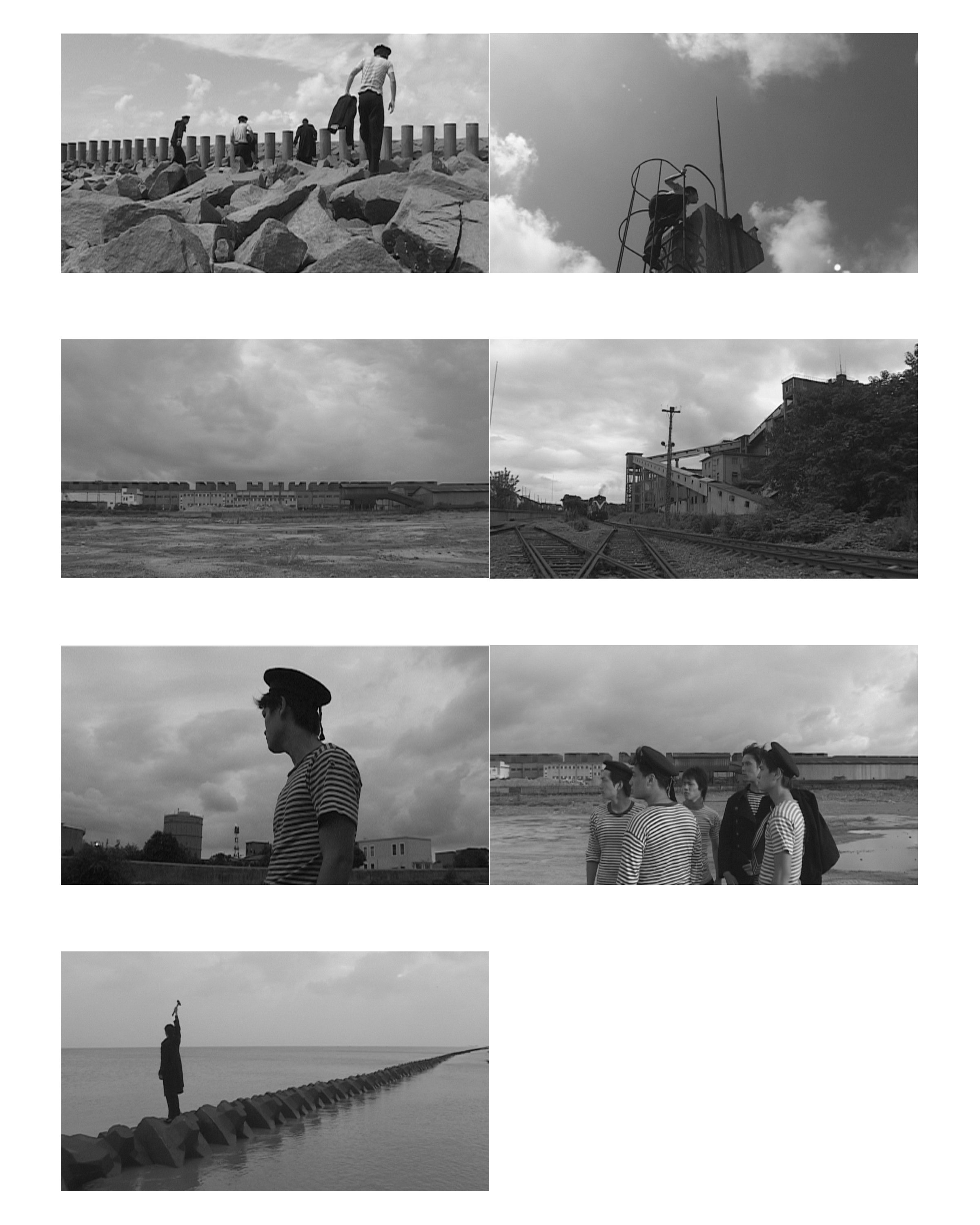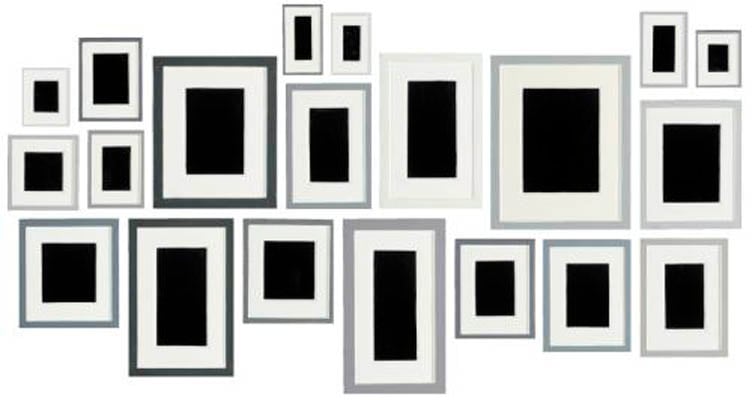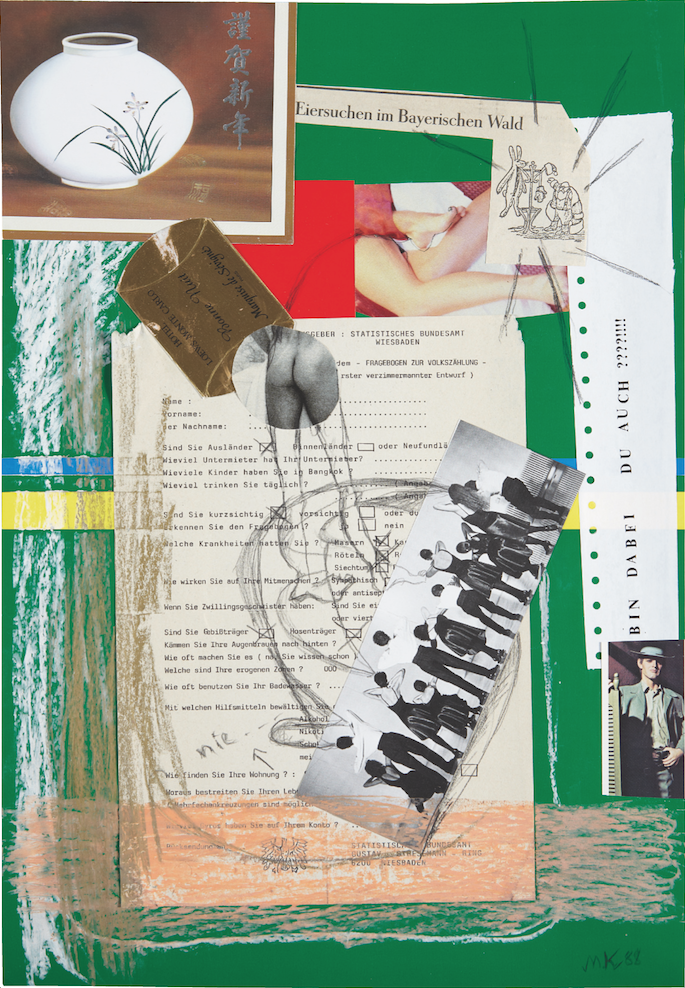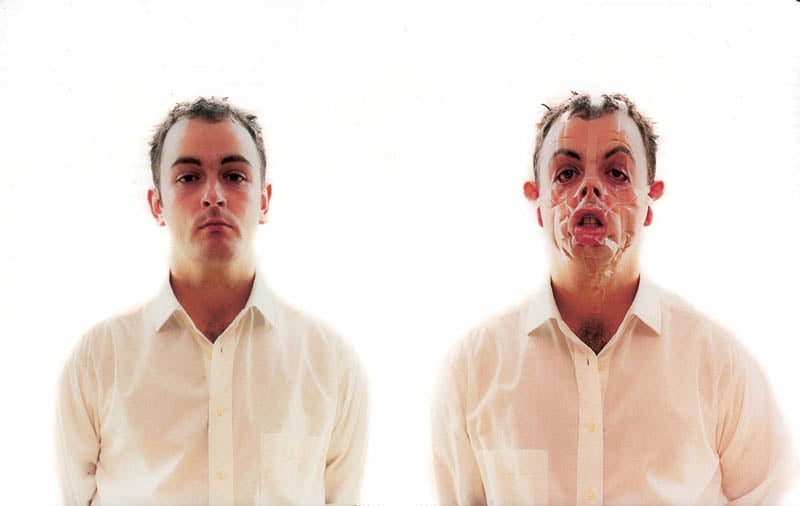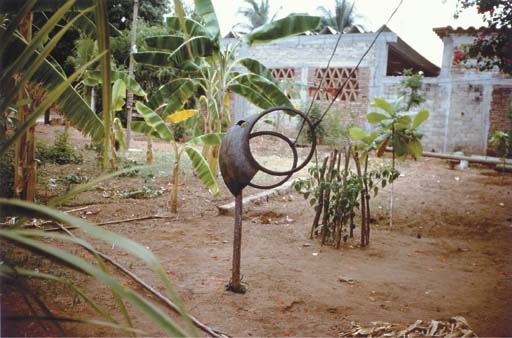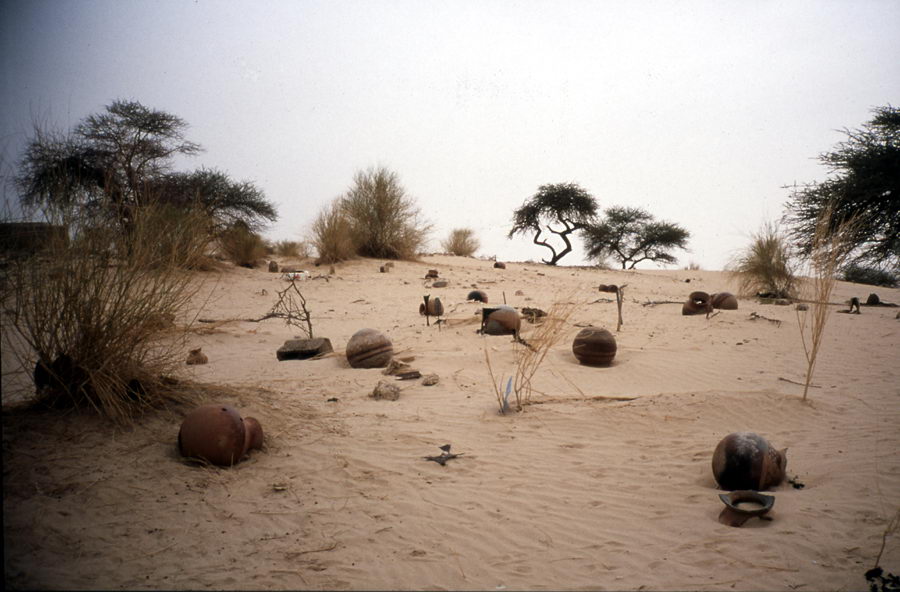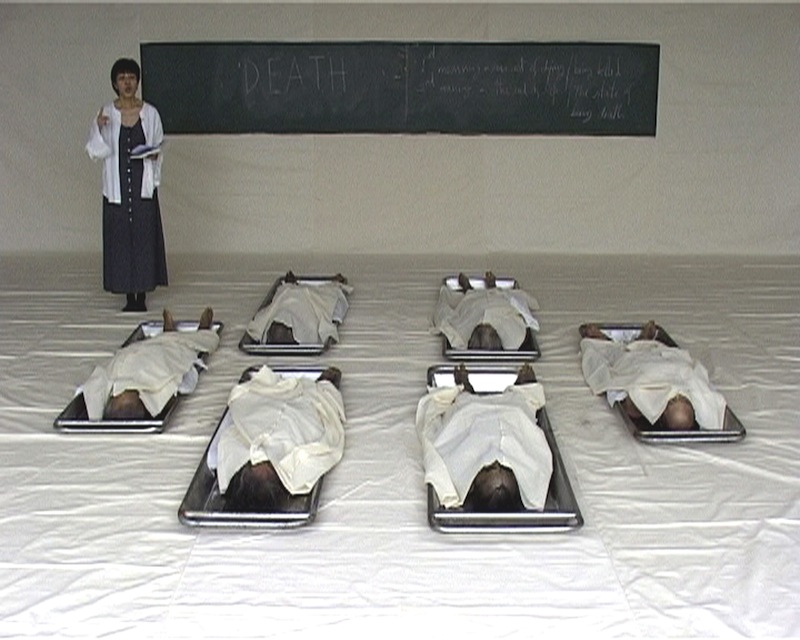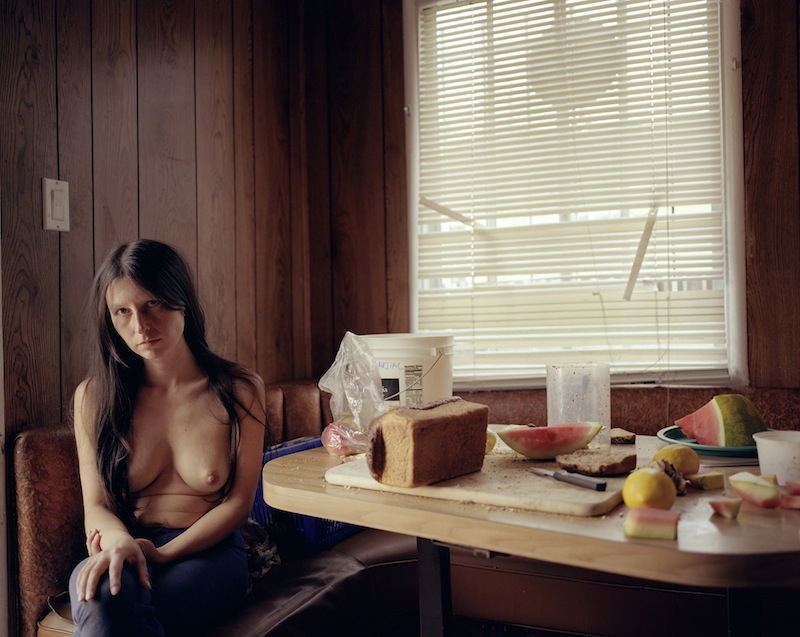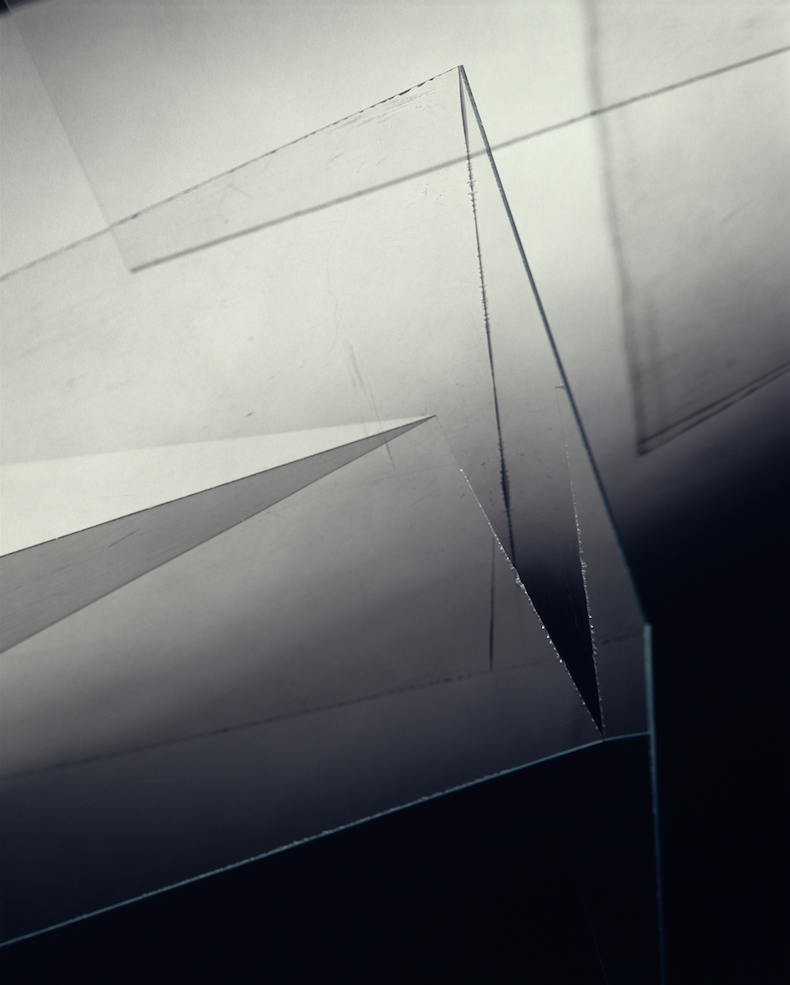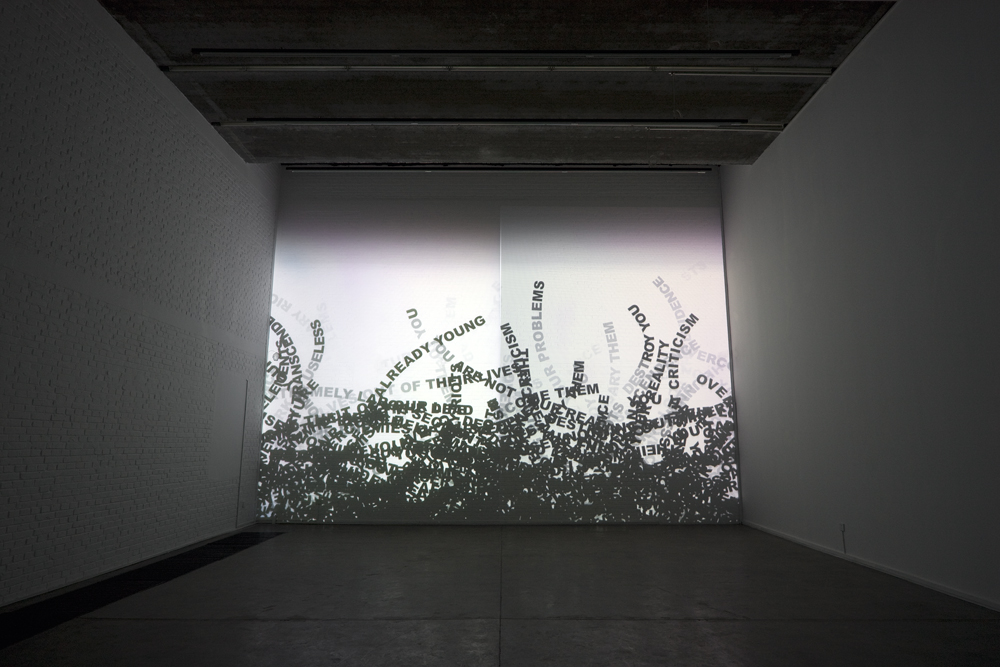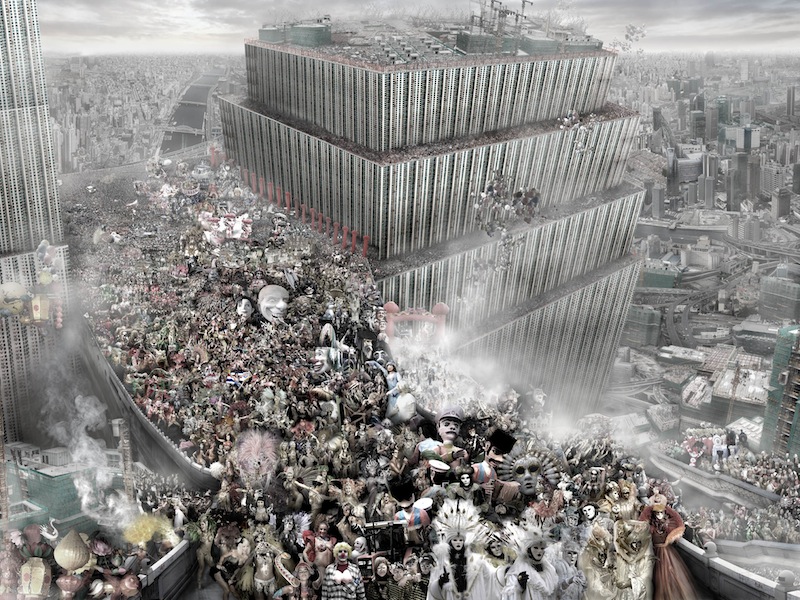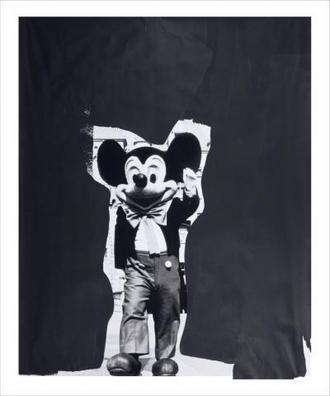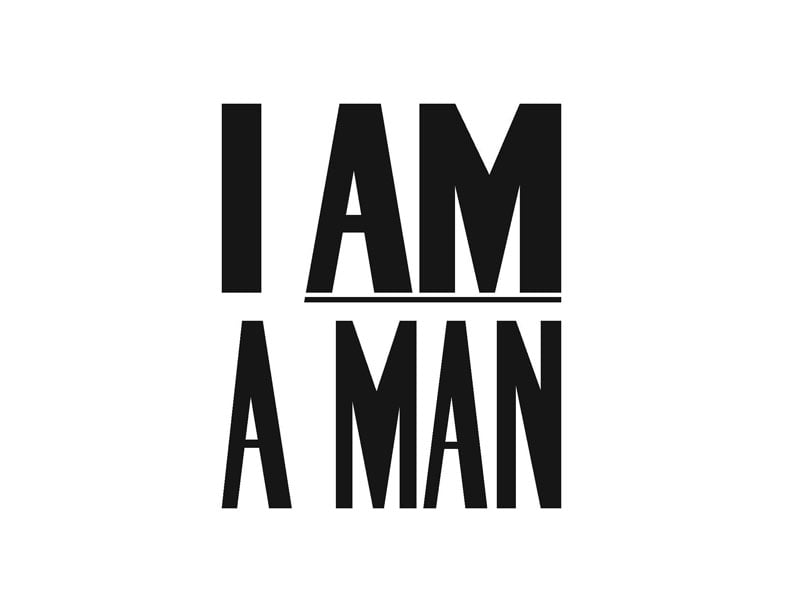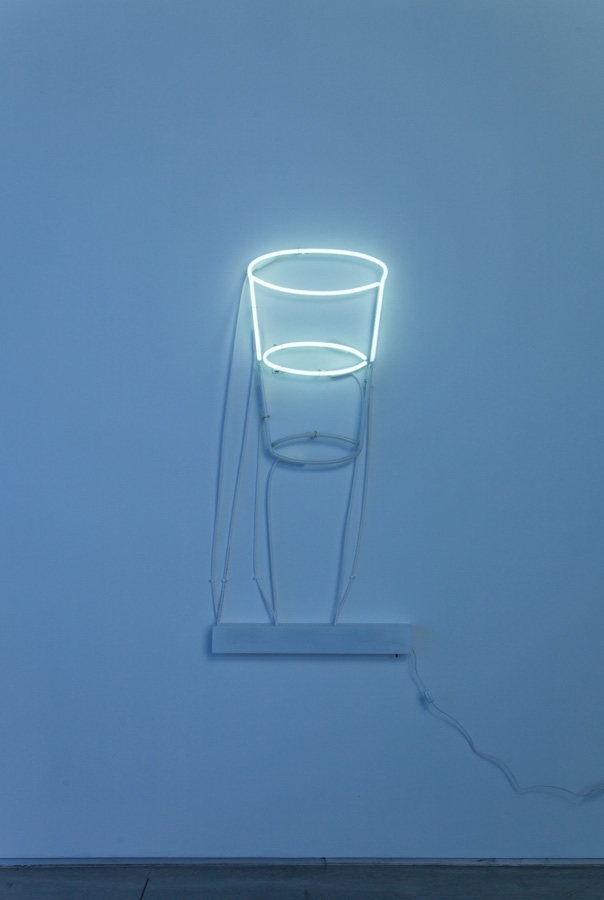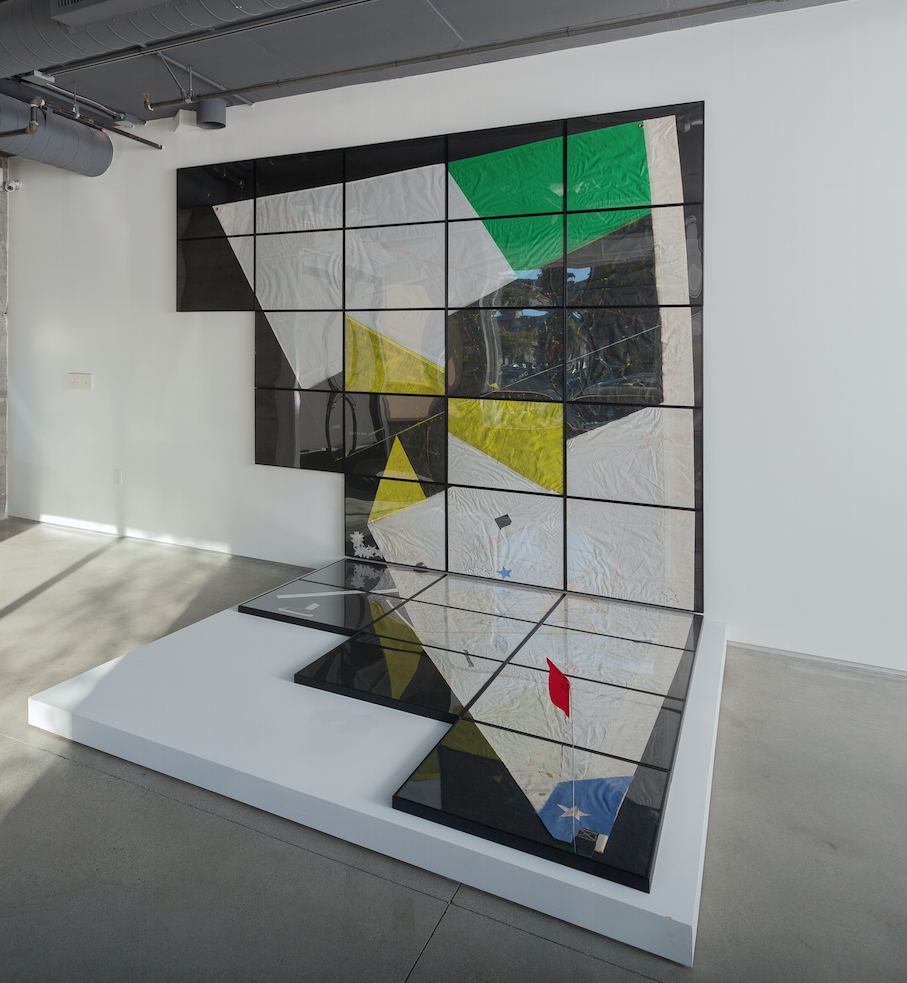
© » KADIST
Vincent Leong
The photograph Exquisite Eco Living is part of a larger series titled Executive Properties in which he digitally manipulated the images to insert iconic buildings of Kuala Lumpur in the view of derelict spaces also found in the city. This images reflect on a dystopian future of the country, perhaps drawing parallel with the political changes in Malaysia.

© » KADIST
Shilpa Gupta
The three monkeys in Don’t See, Don’t Hear, Don’t Speak are a recurring motif in Gupta’s work and refer to the Japanese pictorial maxim of the “three wise monkeys” in which Mizaru covers his eyes to “see no evil,” Kikazaru covers his ears to “hear no evil,” and Iwazaru covers his mouth to “speak no evil.” For the various performative and photographic works that continue this investigation and critique of the political environment, Gupta stages children and adults holding their own or each other’s eyes, mouths and ears. These images suggest that seemingly mobilized societies can actually produce more fear and myths, and that no real freedom is ensured. Instead of facilitating the free circulation of ideas, “advanced” political and technological systems often generate more cultural clichés, wars, and terror.

© » KADIST
Sharon Lockhart
Lockhart’s film Lunch Break investigates the present state of American labor, through a close look at the everyday life of the workers at the Bath Iron Works shipyard—a private sector of the U. S. naval shipbuilding company—in Maine. Stanley “Tom” Durrell, Tinsmith (2008) belongs to a group of portrait-like photographs of the shipyard’s workers lunchboxes. Created over the period of a year, Lockhart’s film and accompanying still photographs are intended as an exploration of the social spaces inside this kind of workplace.

© » KADIST
Wong Hoy Cheong
Created for the tenth Lyon Bienniale, in Days of Our Lives: Playing for Dying Mother, Wong’s ongoing negotiation of postcolonial globalization takes aim at French society. Named after an American daytime soap opera that been running for over forty years, Days of Our Lives is a series of six photographs that explore contemporary Europeaness. Here, domestic, everyday scenes drawn from French paintings in the Museum of Fine Arts in Lyon——preparing food, relaxing, reading and playing music, giving charity to the poor, being evicted from home, or going off to War—are reenacted by Muslim Nigerians, Iranians, Turkish, and Buddhist Burmese minorities.

© » KADIST
Nathaniel Dorsky
Dorsky’s pieces included in the Kadist Collection are small still photographs from twelve of his most important films. Here, the still images function in the same way as his cinematographic work: Highly aesthetic, they allow for the appearance of intricate visual patterns and layers of meaning that take scenes of everyday life as its source material. Both Dorsky’s cinematic and photographic works follow a stream of consciousness that rejects representation or fixed narrative structure.

© » KADIST
Walead Beshty
Constructed out of metal or glass to mirror the size of FedEx shipping boxes, and to fit securely inside, Walead Beshty’s FedEx works are then shipped, accruing cracks, chips, scrapes, and bruises along the way to their destination. Displayed with the cardboard boxes (and their shipping labels, which chart the journey in a different way) that contain them during the journey, these damaged forms draw from minimalist sculpture, and conceptual artworks that focused on distance, travel, and virtual connections.

© » KADIST
Yee I-Lann
7-headed Lalandau Hat by Yee I-Lann is an intricately woven sculpture evoking the ceremonial headdress worn by Murut men in Borneo. The materiality and form of this traditional headpiece represents the strength and fierceness of forest warriors. Their ‘chimneys’ on top are intended to resemble trees in the jungle onto which hornbill feathers would once have been stuffed.

© » KADIST
Paul Kos
Taking its title from the eponymous mythological creature—famously featured as sea nymphs in Homer’s Odyssey. Sirens exist in literature across many cultures including Ancient Greece and India, described as part bird and part woman, or like a mermaid. They were said to charm men by their song, and, having first lulled them to sleep, tear them to pieces.
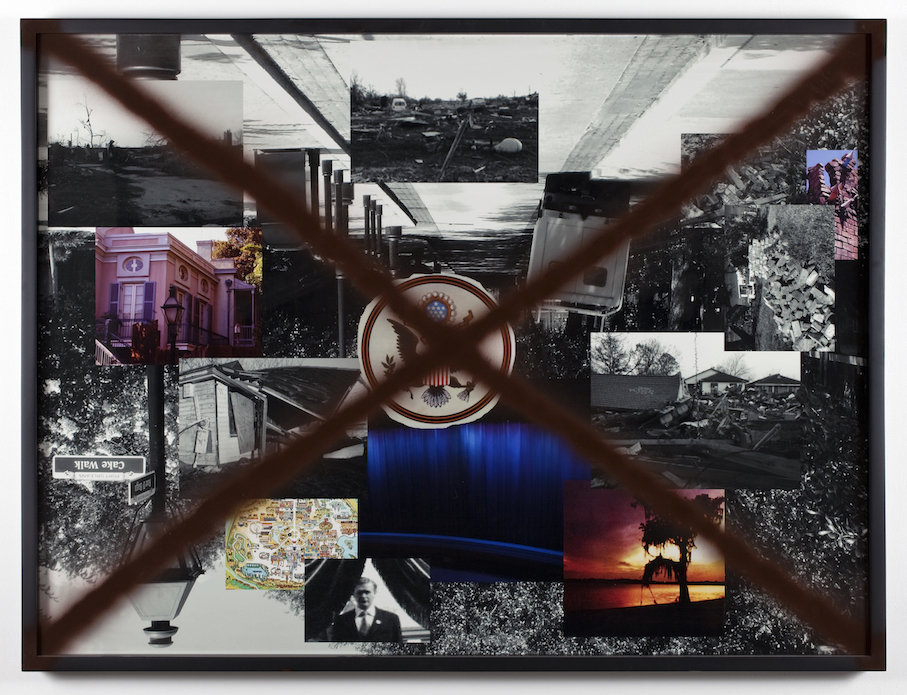
© » KADIST
Stephen G. Rhodes
For his series of digital collages Excerpt (Sealed)… Rhodes appropriated multiple images from mass media and then sprayed an X on top of their glass and frame. This visual seal refers to the disastrous aftermath of Hurricane Katrina in 2005 in which rescue workers spray painted the doors of the houses they searched giving the date, the team and the number of bodies found. Excerpt (Sealed) (Brown) is a multilayered collage with contradictory imagery—from New Orleans debris to the American eagle and a theater curtain.

© » KADIST
John Houck
Houck’s Peg and John was made as part of a series of photographic works that capture objects from the artist’s childhood. In this image, drafting materials (pencils, compasses, and protractors) are laid out next to shotgun shell casings. Presenting these objects in juxtaposition but without commentary, Houck offers a partial but interesting glimpse into his own biography.

© » KADIST
Mungo Thomson
Starting with Bruce Nauman’s iconic artwork, The True Artist Helps the World by Revealing Mystic Truths (Window or Wall Sign) , Mungo Thomson’s neon sign is one of a series that replaces Nauman’s quixotic mini-manifesto with aphorisms from ‘recovery’ culture, especially those made popular by alcoholics anonymous. Thomson is referencing the lore that Nauman’s work (the first of many neons he’d make in the following years) had been inspired by a neon beer sign found in a corner-store in San Francisco that he used as his studio in the late 60s. This particular work has a self-critical subtext, as it also suggests the act of using another artist’s work, in an endless spiral of influence, is akin to a form of insanity.

© » KADIST
Oded Hirsch
Oded Hirsch’s video work Nothing New (2012) utilizes seemingly absurdist tropes to raise more trenchant questions about communal action and collective identity in modern day Israel. In the video, a fallen parachutist hangs tangled by his own lines, suspended between two electrical towers in a surreally desolate landscape of overgrown fields in the Jordan Valley of Israel. A group of over a hundred men and women approach the towers, working with almost mechanic efficiency to free the parachutist from the power lines overhead.
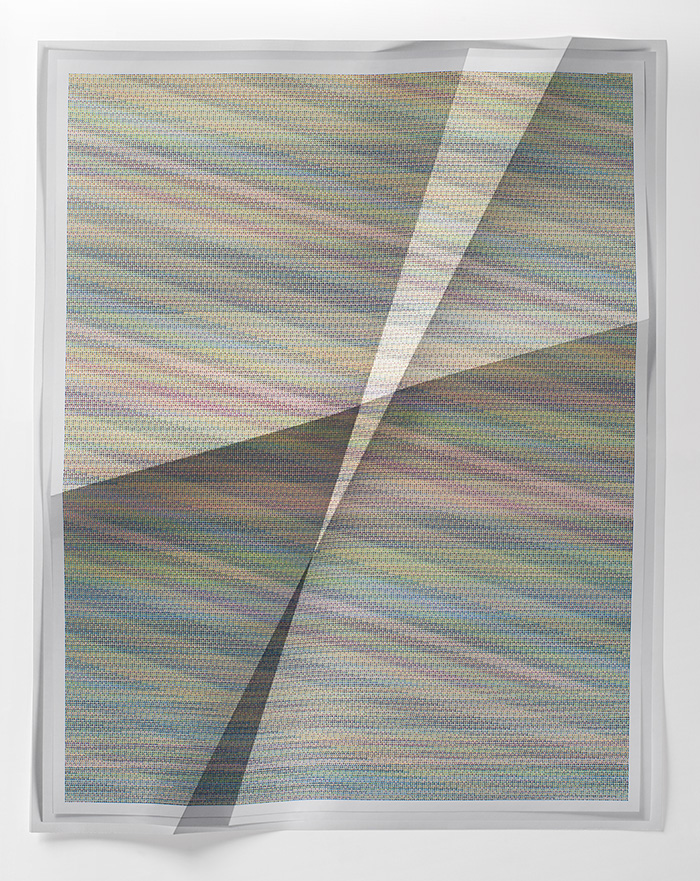
© » KADIST
John Houck
Untitled #242 is part of Houck’s Aggregates Series, which uses digital tools to manipulate chosen sets and pairs of colors, creating colorful index sheets, bathed in colors and lines. Houck transforms these simple outputs physically, folding, lighting, photographing, and re-printing them, only to fold, photograph, and re-print again. An MFA graduate from UCLA, John Houck works primarily in the medium of photography and specializes in still-life vignettes.

© » KADIST
Hank Willis Thomas
Drawing & Print (Drawing & Print)
Intentionally Left Blanc alludes to the technical process of its own (non)production; a procedure known as retro-reflective screen printing in which the image is only fully brought to life through its exposure to flash lighting. Using a found photograph depicting a passionate crowd of African Americans—their attitude suggesting the fervor of a civil-rights era audience— Intentionally Left Blanc reverts in its exposed, “positive” format to an image in which select faces are whitened out and erased, the exact inverse of the same view in its “negative” condition. This dialectic of light and dark re-emerges when we view the same faces again, only this time black and featureless, a scattering of disembodied heads amidst a sea of white.

© » KADIST
Allan Sekula
San Pedro is a seaside city, part of the Los Angeles Harbor, sitting on the edge of a channel. California Stories: Attempt to correlate social class with elevation above main harbor channel (San Pedro, July 1975) (1973–2011) is a series of coupled gelatin silver prints that show the artist using his hand to measure the elevation of various pieces of real estate, ranging from a manicured mansion to a ramshackle beach house. A direct equation becomes evident between the social strata these homes represent and the height at which the artist holds his hand.

© » KADIST
Jeff Burton
Negligee (2013) serves as an example of this tension, with its artful angle and play with shadow and light upon the sensual subject, rendering the image ambiguous. Like much of Burton’s work, Negligee reflects both his experience as a commercial photographer and his interest in the voyeurism, desire, vulnerability, and power of the photographic act.

© » KADIST
Richard T. Walker
let this be us is a single-channel video by Richard T. Walker featuring the artist himself roaming around the wilderness of a deserted landscape, sporadically humming a melody, strumming a guitar, or playing a few notes on a keyboard. As he traverses between striking locations we see him carrying large photographic prints of the same landscape that he is treading, which he then rests onto tripods so that the horizon in the photograph seamlessly matches that of the real landscape. As we hear the music, Walker comes in and out of view, dissipating into the landscape as his body becomes invisible, hidden behind the photographic prints.

© » KADIST
John Houck
Baby Shoes, Never Worn is part of photographer John Houck’s series of restrained still-life photographs capturing objects from his childhood. The image depicts a box, addressed to the artist’s mother, that once contained—it can be assumed—baby shoes. Houck layers the photograph with multiple exposures, lending an uneasy tripling effect to the static object.

© » KADIST
Yan Xing
The title of this series – Two videos, three photographs, several related masterpieces and American art – is paradoxical, suggesting the work is conceived in relation to its medium and a situation in art history and the region of the world in which it was made. Paradoxical but in the end, often true of the way in which art history is written. The presence of black men and the term “American Art” brings us back to Robert Mapplethorpe’s Black Book .

© » KADIST
Daniel Joseph Martinez
Martinez’s sculpture A meditation on the possibility… of romantic love or where you goin’ with that gun in your hand , Bobby Seale and Huey Newton discuss the relationship between expressionism and social reality in Hitler’s painting depicts the legendary Black Panther leaders Huey P. Newton and Bobby Seale. By using Carrara marble, a material usually associated with heroic public sculptures, Martinez casts the history of African-American revolutionaries into the artistic tradition of monumentality. Like the artist’s earlier work included in the 1993 Whitney Biennial, an interactive piece made up with pins that read, “I CAN’T IMAGINE EVER WANTING TO BE WHITE,” A meditation on the possibility… continues Martinez’s effort to expose cultural contradictions and increase public awareness.

© » KADIST
Luisa Lambri
Custom-built for a silent film star in 1934 in Santa Monica, the Sten-Frenke House is an idiosyncratic icon. Designed by the architect Richard Neutra, its gray glass, white expanses, and simple forms exude austerity. Luisa Lambri’s photograph Untitled (Sten-Frenke House #04) (2007)recalls the unembellished elegance of the structure while also alluding to modernist painting; the image is less a picture than an abstract expanse that conveys its own flatness.

© » KADIST
Gabriel Orozco
Gabriel Orozco often documents found situations in the natural or urban landscape. He travels armed with his camera and insightfully captures scenes of the everyday that other people might ignore. Perro en Tlalpan (Dog in Tlalpan, 1992) is a photograph of a dog regally perched under an industrial shelter in the borough of Tlalpan in Mexico City.

© » KADIST
John Baldessari
Arms & Legs (Specif. Elbows & Knees), etc. : Arm (with Bottle) belongs to Baldessari’s most recent series of paintings in which the artist brings together photographic, painted, and three-dimensional elements, to juxtapose unlikely body fragments such as noses and ears, elbows and knees, or eyebrows and foreheads.

© » KADIST
Tacita Dean
The photographic quality of the film Baobab is not only the result of a highly sophisticated use of black and white and light, but also of the way in which each tree is characterized as an individual, creating in the end a series of portraits. The monumental and unnatural aspect of the baobabs turns them into strange and anthropomorphic personalities. Adding to the descriptive aspect of the film, the sound is a recording of the environment, of sounds made by animals, and participates in this peaceful contemplation.

© » KADIST
Catherine Opie
Although best known as a provocateur and portraitist, Opie also photographs landscapes, cityscapes, and architecture. The Freeway Series was developed in 1995, right after the artist’s inclusion in that year’s Whitney Biennial. As if suggesting that her work should not be restricted to being seen through overtly political or activist lenses, this series lends insight into the city of Los Angeles via its most characteristic urban feature: its highways.
Hank Willis Thomas
- location: New York, New York
- year born: 1976
- gender: male
- nationality: American
- home town: Plainfield, New Jersey
Catherine Opie
- location: Los Angeles, California
- year born: 1961
- gender: female
- nationality: American
- home town: Sandusky, Ohio
John Houck
- year born: 1977
- gender: male
- nationality: American
- home town: South Dakota
Mungo Thomson
- location: Los Angeles, California
- year born: 1969
- gender: male
- nationality: American
Lynn Hershman Leeson
- location: San Francisco, California
- year born: 1941
- gender: female
- nationality: American
- home town: Cleveland, Ohio
Shilpa Gupta
- location: Mumbai, India
- year born: 1976
- gender: female
- nationality: Indian
- home town: Mumbai, India
Walead Beshty
- location: Los Angeles, California
- year born: 1976
- gender: male
- home town: London, United Kingdom
Paul Kos
- location: San Francisco, California
- year born: 1942
- gender: male
- nationality: American
Gabriel Orozco
- location: New York City, Paris
- location: Mexico
- year born: 1962
- gender: male
- nationality: Mexican
- home town: Jalapa, Mexico
Paul McCarthy
- location: Los Angeles, California
- year born: 1945
- gender: male
- nationality: American
- home town: Salt Lake City, Utah
Yee I-Lann
- location: Kuala Lumpur, Malaysia
- year born: 1971
- gender: female
- nationality: Malaysian
- home town: Sabah, Malaysia
Martin Kippenberger
- location: Vienna, Austria
- year born: 1953
- gender: male
- nationality: German
- home town: Dortmund, Germany
Luisa Lambri
- location: Los Angeles, California
- year born: 1969
- gender: female
- nationality: Italian
- home town: Como, Italy
Sharon Lockhart
- year born: 1964
- gender: female
- nationality: American
- home town: Norwood, Massachusetts
Douglas Gordon
- location: Berlin, Germany
- year born: 1966
- gender: male
- nationality: Scottish
- home town: Glasgow, United Kingdom
Du Zhenjun
- location: Paris, France
- location: Shanghai, China
- year born: 1961
- gender: male
- nationality: Chinese
- home town: Shanghai, China
Enrique Ramirez
- year born: 1979
- gender: male
- nationality: Chilean
- home town: Santiago, Chile
Daniel Joseph Martinez
- location: Los Angeles, California
- year born: 1957
- gender: male
- nationality: American
- home town: Los Angeles, California
John Baldessari
- location: Los Angeles, California
- year born: 1931
- gender: male
- nationality: American
- home town: National City, California
Wong Hoy Cheong
- location: Kuala Lumpur, Malaysia
- year born: 1960
- gender: male
- nationality: Malaysian
- home town: George Town, Malaysia
Hans-Peter Feldmann
- location: Düsseldorf, Germany
- year born: 1941
- gender: male
- nationality: German
- home town: Dusseldorf, Germany
Yan Xing
- location: Beijing, China
- year born: 1986
- gender: male
- nationality: Chinese
- home town: Chongqing, China
Jiang Zhi
- location: Beijing
- location: Shenzhen, China
- year born: 1971
- gender: male
- nationality: Chinese
- home town: Yuanjiang, China
Pascal Shirley
Pascal Shirley’s photographs portray a California of beaches, music festivals, families, and hipsters wandering through the hills...
Yto Barrada
- location: Tangier, Morocco
- year born: 1971
- gender: male
- nationality: French-Moroccan
- home town: Paris, France
Jeff Burton
- location: Los Angeles, California
- year born: 1963
- gender: male
- nationality: American
- home town: Anaheim, California
Lu Chunsheng
- location: Shanghai, China
- year born: 1968
- gender: male
- nationality: Chinese
- home town: Changchun, Jilin province, China
Cerith Wyn Evans
- location: London, United Kingdom
- year born: 1958
- gender: male
- nationality: British
- home town: Llanelli, United Kingdom
Rodney Graham
- location: Vancouver, Canada
- year born: 1949
- gender: male
- nationality: Canadian
- home town: Vancouver, Canada

© » ROYAL ACADEMY
about 21 months ago (10/05/2023)
Video: Catherine Opie on photographing leading British artists | Blog | Royal Academy of Arts Catherine Opie in the RA Collection Gallery Video: Catherine Opie on photographing leading British artists Read more Become a Friend Video: Catherine Opie on photographing leading British artists Published 8 September 2023 Catherine Opie discusses her portraits of David Hockney, Anish Kapoor, Gillian Wearing, Isaac Julien and Lynette Yiadom-Boakye, featured in our free display in the Collection Gallery...
-
1970-1979
Allen Ruppersberg
1970Untitled (City Limits) is a series of five black-and-white photographs of road signs, specifically the signs demarcating city limits of several small towns in California...
Allan Sekula
1973San Pedro is a seaside city, part of the Los Angeles Harbor, sitting on the edge of a channel...
Daniel Joseph Martinez
1978For I use to eat lemon meringue pie till I overloaded on my pancreas with sugar and passed out; It seemed to be a natural response to a society of abundance (1978), also known as the Bodybuilder series, Martinez asked male bodybuilding competitors to pose in whatever position felt “most natural.” They are obviously trained in presenting their ambitiously carved physiques, but their facial expressions seem comparatively unstudied...
-
1980-1989
Allan McCollum
1982In the work titled The Glossies (1980), an affinity for photography manifested itself before McCollum actually began to use photography as a medium...
Paul McCarthy
1983McCarthy’s Mother Pig performance at Shushi Gallery in 1983 was the first time he used a set, a practice which came to characterize his later works...
Robert Therrien
1985In No Title (Blue Chapel) Therrien has reduced the image of a chapel to a polygon...
Catherine Opie
1987In this work, a woman sits on a couch with her shirt pulled up to expose her pierced nipples, which are connected by a chain...
Catherine Opie
1987Catherine Opie’s candid photograph Cathy (bed Self-portrait) (1987) shows the artist atop a bed wearing a negligee and a dildo; the latter is attached to a whip that she holds in her teeth...
Martin Kippenberger
1988Martin Kippenberger’s late collages are known for incorporating a wide range of materials, from polaroids and magazine clips to hotel stationery, decals, and graphite drawings...
Martin Kippenberger
Drawing & Print
1989(Drawing & Print) 7″ Single ‘Pop In’ by Martin Kippenbergher consisting of a vinyl record and a unique artwork drawn by the artist on the record’s sleeve...
Martin Kippenberger
Drawing & Print
1989(Drawing & Print) Untitled is a work on paper by Martin Kippenberger comprised of several seemingly disparate elements: cut-out images of a group of dancers, a japanese ceramic vase, and a pair of legs, are all combined with gestural, hand-drawn traces and additional elements such as a candy wrapper from a hotel in Monte Carlo and a statistical form from a federal government office in Wiesbaden, Germany...
-
1990-1999
Rodney Graham
1991Ponderosa Pine IV belongs to a series of large-scale photographs of trees taken by Graham and depicts a particular species that live in Northern California...
John Baldessari
Drawing & Print
1991(Drawing & Print) The voids in Baldessari’s painted photographs are simultaneously positive and negative spaces, both additive and subtractive...
Gabriel Orozco
1992Gabriel Orozco often documents found situations in the natural or urban landscape...
Catherine Opie
1993Like many of Opie’s works, Mike and Sky presents female masculinity to defy a binary understanding of gender...
Catherine Opie
1994Although best known as a provocateur and portraitist, Opie also photographs landscapes, cityscapes, and architecture...
Gabriel Orozco
1994Charco portátil congelado (Frozen Portable Puddle, 1994) is a photographic record of an installation of the same name that Gabriel Orozco made at Witte de With Center for Contemporary Art in Rotterdam for the group exhibition WATT (1994)...
Jennifer Bornstein
1994Collectors’ Favorites is an episode of local cable program from the mid-1990s in which ordinary people were invited to present their personal collections—a concept that in many ways anticipates current reality TV shows and internet videos...
Rodney Graham
1996Tree on the Former Site of Camera Obscura (1996) belongs to a series of large-scale photographs of trees taken by Graham and depicts a particular species that lives in Northern California...
Douglas Gordon
1996In Monster (1996-97), the artist’s face becomes grotesque through the application of strips of transparent adhesive tape, typical of Gordon’s performance-based films that often depict his own body in action...
John Baldessari
1997In One Must , an image of a pair of scissors, accompanied by the words of work’s title, poses an ominous question about the relationship between the image and the text...
-
2000-2009
Glenn Ligon
Drawing & Print
2000(Drawing & Print) Glenn Ligon’s diptych, Condition Repor t is comprised of two side-by-side prints...
Tacita Dean
2001The photographic quality of the film Baobab is not only the result of a highly sophisticated use of black and white and light, but also of the way in which each tree is characterized as an individual, creating in the end a series of portraits...
Luisa Lambri
2002Lambri’s careful framing in Untitled (Miller House, #02) redefines our understanding of this iconic mid-century modernist building located in Palm Springs, California...
Douglas Gordon
2002Blind Spencer is part of the series “Blind Stars” including hundreds of works in which the artist cut out the eyes of Hollywood stars, in a symbolically violent manner...
Gabriel Orozco
2002Gabriel Orozco comments: “In the exhibition [Documenta 11, Kassel, 2002], I tried to connect with the photographs I took in Mali in July...
Yto Barrada
2004In this photographic series, Yto Barrada was interested in the logos of the buses that travel between North Africa and Europe...
Francis Alÿs
2004The Nightwatch , which is an ironic reference to the celebrated painting by Rembrandt, follows the course of a fox wandering among the celebrated collections of the National Portrait Gallery in London...
Wong Hoy Cheong
2004Re: Looking marks a new phase in Wong’s work which connects his region’s history with other parts of the world...
Douglas Gordon
2004Douglas Gordon’s single-channel video The Left Hand Can’t See That The Right Hand is Blind, captures an unfolding scene between two hands in leather gloves—at first seemingly comfortable to be entwined, and later, engaged in a struggle...
Lu Chunsheng
2004A mesmerizing experience of a vaguely familiar yet remote world, History of Chemistry I follows a group of men as they wander from somewhere beyond the edge of the sea through a vast landscape to an abandoned steel factory...
Daniel Joseph Martinez
2005Martinez’s sculpture A meditation on the possibility… of romantic love or where you goin’ with that gun in your hand , Bobby Seale and Huey Newton discuss the relationship between expressionism and social reality in Hitler’s painting depicts the legendary Black Panther leaders Huey P...
Araya Rasdjarmrearnsook
2005The Class (2005) by Araya Rasdjarmrearnsook challenges the viewer’s personal sense of morality and tolerance by depicting a classroom from hell...
Pascal Shirley
2006Gypsy shows an ambivalent scene, in which broken blinds and its unsmiling subject are balanced with the stilllife plentitude of watermelon slices and the beautifully lit nudity of the sitter...
Qing Zhang
2006603 Football Field presents a soccer game played inside a small student apartment in Shanghai...
Pascal Shirley
2006Like many of Pascal Shirley’s photographs, Oakland Girls aestheticizes a dingy rooftop and a cloudy sky...
Francis Alÿs
Drawing & Print
2006(Drawing & Print) This series of small drawings is executed with varying materials—pen, ink, colored pencil, charcoal, and masking tape—on architect’s tracing paper...
Luisa Lambri
2007Custom-built for a silent film star in 1934 in Santa Monica, the Sten-Frenke House is an idiosyncratic icon...
Trisha Donnelly
2007Untitled is a black-and-white photograph of a wave just before it breaks as seen from the distance of an overlook...
Lynn Hershman Leeson
2007Lynn Hershman Leeson’s genre-bending documentary Strange Culture tells the story of how one man’s personal tragedy turns into persecution by a paranoid, conservative, and overzealous government...
Luisa Lambri
2007Rudolph Schindler’s designs, part of a practice he called “Space Architecture,” marry interior with exterior and space with light...
Simon Starling
2007Invited in 2007 to the Museum Folkwang in Essen (Germany), Simon Starling questioned its history: known for its collections and particularly for its early engagement in favor of modern art (including the acquisition and exhibition of works by Cézanne, Gauguin, Van Gogh, Matisse), then destroyed during the Second World War, the museum was pillaged for its masterpieces of ‘degenerate art’ by the nazis...
Piero Golia
2007Golia’s Untitled 3 is an installation in which a mechanical device is programmed to shoot clay pigeons that are thrown up in front of a white wall...
Gimhongsok
2007To explore the boundaries between artwork and audience, Gimhongsok created a series of sculptural performances in which a person wearing an animal costume poses in the gallery...
Yto Barrada
2007This photograph is part of the series titled “Iris Tingitana project” (2007) focusing on the disappearance of the iris...
Aaron Young
2007The artist describes the work as “very performative video-pieces but they take on a more sculptural feel...
Shilpa Gupta
2008The three monkeys in Don’t See, Don’t Hear, Don’t Speak are a recurring motif in Gupta’s work and refer to the Japanese pictorial maxim of the “three wise monkeys” in which Mizaru covers his eyes to “see no evil,” Kikazaru covers his ears to “hear no evil,” and Iwazaru covers his mouth to “speak no evil.” For the various performative and photographic works that continue this investigation and critique of the political environment, Gupta stages children and adults holding their own or each other’s eyes, mouths and ears...
Sharon Lockhart
2008Lockhart’s film Lunch Break investigates the present state of American labor, through a close look at the everyday life of the workers at the Bath Iron Works shipyard—a private sector of the U...
Paul McCarthy
2008Memory Mistake of the Eldridge Cleaver Pants was created for the show Paul McCarthy’s Low Life Slow Life Part 1 , held at California College of the Arts’s Wattis Institute in 2008 and curated by McCarthy himself...
Alessandro Balteo Yazbeck
2008Part of a larger series of photographic works, Alessandro Balteo Yazbeck’s Corrupted file from page 14 (V1) from the series La Vega, Plan Caracas No...
Jonathan Hernández
2008In line with Hernández’s interest in catastrophe, Vulnerabilia (choques) is a collection of images of shipwrecks and Vulnerabilia (naufragios) collects scenes of car crashes...
Barbara Kasten
2008Barbara Kasten’s Studio Construct 51 depicts an abstract still life: a greyscale photograph of clear translucent panes assembled into geometric forms, the hard lines of their edges converging and bisecting at various points...
Mungo Thomson
Drawing & Print
2008(Drawing & Print) The White Album (2008) presents a compilation of one hundred issues of Artforum magazine released between 1970 and 1979...
Cerith Wyn Evans
2008Untitled (Perfect Lovers + 1) by Cerith Wyn Evans takes as its starting point Felix Gonzales-Torres’s seminal work Untitled (Perfect Lovers) , in which two clocks were synchronized and left to run without interference, the implication being that one would stop before the other...
Sharon Lockhart
2008Lockhart’s film Lunch Break investigates the present state of American labor through a close look at the everyday life of the workers at the Bath Iron Works shipyard—a private sector of the U...
Wong Hoy Cheong
2009Created for the tenth Lyon Bienniale, in Days of Our Lives: Playing for Dying Mother, Wong’s ongoing negotiation of postcolonial globalization takes aim at French society...
Wong Hoy Cheong
2009Days of Our Lives: Reading is from a series of work was created for the 10th Biennale de Lyon by the artist...
Doug Aitken
2009The version of Frontier acquired by the Kadist Collection consists of a single-channel video, adapted from the monumental installation and performance that Aitken presented in Rome, by the Tiber River, in 2009...
Mario Ybarra Jr.
2009Ammo Bunker (2009) is a multipart installation that includes large-scale wall prints and an architectural model...
Shilpa Gupta
2009In Untitled (Sword) , addressing histories of colonialism with abstraction, a large steel blade extends from the gallery wall...
Rodrigo Braga
2009Braga’s video work Provisão (2009) opens with a still shot of a clearing in a forest, shoots of grass emerging from a muddy brown patch of seemingly dry and barren earth...
-
2010-2019
Nathaniel Dorsky
2010Dorsky’s pieces included in the Kadist Collection are small still photographs from twelve of his most important films...
Stephen G. Rhodes
2010For his series of digital collages Excerpt (Sealed)… Rhodes appropriated multiple images from mass media and then sprayed an X on top of their glass and frame...
Walead Beshty
2010Black Curl (CMY/Five Magnet: Irvine, California, March 25, 2010, Fujicolor Cyrstal Archive Super Type C, EM No 165-021, 05910) is a visually compelling photogram...
Du Zhenjun
2010The Tower of Babel is an installation of large-format photographs that forces the audience to occupy a central position through its monumental scale...
Motoyuki Daifu
2010Seven family members and a cat all squeezed into the small five-room house, where Motoyuki Daifu grew up in Yokohama...
Mungo Thomson
2010In Thomson’s Untitled (TIME) , every front cover of TIME magazine is sequentially projected to scale at thirty frames per second...
Du Zhenjun
2010The Tower of Babel is an installation of large-format photographs that forces the audience to occupy a central position through its monumental scale...
Paul McCarthy
Drawing & Print
2010(Drawing & Print) To make Mickey Mouse (2010), Paul McCarthy altered a found photograph—not of the iconic cartoon, but of a man costumed as Mickey...
Carlos Garaicoa
2010From the series the Old and the New (XI) by Carlos Garaicoa belongs to the series Lo viejo y lo nuevo / Das Alte und das Neue (The Old and the New) which was first exhibited in 2010 at Barbara Gross Gallery in Germany...
Du Zhenjun
2010The Tower of Babel is an installation of large-format photographs that forces the audience to occupy a central position through its monumental scale...
Walead Beshty
2011Constructed out of metal or glass to mirror the size of FedEx shipping boxes, and to fit securely inside, Walead Beshty’s FedEx works are then shipped, accruing cracks, chips, scrapes, and bruises along the way to their destination...
Sharon Lockhart
2011Visalia Livestock Market, Visalia, California results from Lockhart’s prolonged investigation of an agricultural center and community...
Lucas Blalock
2011Compositions such as Tree on Keystone (2011) become hyperreal versions of their real-world equivalents...
Wimo Ambala Bayang
2011Composed of four images, the series Sleeping Elephant in the Axis of Yogyakarta (2011) explores the artist’s observation of how Javanese mythology and cosmology have marked the geography of Yogyakarta, the cultural centre of Indonesia...
Hank Willis Thomas
Drawing & Print
2012(Drawing & Print) Intentionally Left Blanc alludes to the technical process of its own (non)production; a procedure known as retro-reflective screen printing in which the image is only fully brought to life through its exposure to flash lighting...
Oded Hirsch
2012Oded Hirsch’s video work Nothing New (2012) utilizes seemingly absurdist tropes to raise more trenchant questions about communal action and collective identity in modern day Israel...
Vincent Leong
2012The photograph Exquisite Eco Living is part of a larger series titled Executive Properties in which he digitally manipulated the images to insert iconic buildings of Kuala Lumpur in the view of derelict spaces also found in the city...
Walead Beshty
2012Constructed out of metal or glass to mirror the size of FedEx shipping boxes, and to fit securely inside, Walead Beshty’s FedEx works are then shipped, accruing cracks, chips, scrapes, and bruises along the way to their destination...
Yang Zhenzhong
2012Peasant Sensation Passing Through Flesh – 3 consists of a massage chair fixed to a wall...
Clarissa Tossin
2012In Fordlândia Fieldwork (2012), Tossin documents the remains of Henry Ford’s rubber enterprise Fordlândia, built in 1928 in the Brazilian Amazon to export cultivated rubber for the booming automobile industry...
Hank Willis Thomas
Drawing & Print
2012(Drawing & Print) Thomas’ lenticular text-based works require viewers to shift positions as they view them in order to fully absorb their content...
Jeff Burton
2012In Eniko Mihalik (2012), the camera captures a glimpse of the eponymous Hungarian model as seen through a rearview mirror...
Elad Lassry
2012The black-and-white photograph Men (055, 065) (2012) depicts two similarly built young men – young and slim, with dark tousled hair and a square jaw line – seated aside one another in identical outfits...
Adrian Wong
2012Untitled (Grate I/II: Shan Mei Playground/ Grand Fortune Mansion) is part of a series drawn from architectural objects that mark the boundary of public and private spaces Wong encountered while strolling in Hong Kong...
Hank Willis Thomas
2012Like many of his other sculptural works, the source of I am the Greatest is actually a historical photograph of an identical button pin from the 1960s...
Hank Willis Thomas
2012Bread and Roses takes its name from a phrase famously used on picket signs and immortalized by the poet James Oppenheim in 1911...
Jeff Burton
2013Negligee (2013) serves as an example of this tension, with its artful angle and play with shadow and light upon the sensual subject, rendering the image ambiguous...
John Houck
2013Baby Shoes, Never Worn is part of photographer John Houck’s series of restrained still-life photographs capturing objects from his childhood...
John Houck
2013Houck’s Peg and John was made as part of a series of photographic works that capture objects from the artist’s childhood...
John Houck
2013Untitled #242 is part of Houck’s Aggregates Series, which uses digital tools to manipulate chosen sets and pairs of colors, creating colorful index sheets, bathed in colors and lines...
Hank Willis Thomas
2013The image is borrowed from protests during Civil Rights where African Americans in the south would carry signs with the same message to assert their rights against segregation and racism...
John Houck
2013John Houck’s multi-layered photographic compositions immortalize nostalgic objects from the artist’s childhood, manipulated in the studio and in post-production into unreal still-life arrangements...
Yee I-Lann
2013Sarcastically titled to call attention to the problematic notions underlying colonialism, this photograph shows hundreds of Native Malaysians seated quietly behind one of their colonial oppressors...
Elad Lassry
2013In establishing a deliberate distance between viewer and subject, Lassry raises questions about representation itself and how all portraits are, in effect, fully constructed objects that only gain meaning once we ascribe them with our own personal associations and emotions...
John Houck
2013John Houck’s brown- , sienna- and golden-toned composition, Untitled #185, 65, 535 combinations of a 2×2 grid, 16 colors , features densely packed lines of color moving diagonally across the creased page...
Elad Lassry
2013In his composition, Chocolate Bars, Eggs, Milk, Lassry’s subjects are mirrored in their surroundings (both figuratively, through the chocolate colored backdrop and the brown frame; and literally, in the milky white, polished surface of the table), as the artist plays with color, shape, and the conventions of representational art both within and outside of the photographic tradition...
Lucas Blalock
Drawing & Print
2013(Drawing & Print) Blalock resists the immediacy that we have come to expect from photography—that each photograph should communicate its message without delay...
Mungo Thomson
2014Starting with Bruce Nauman’s iconic artwork, The True Artist Helps the World by Revealing Mystic Truths (Window or Wall Sign) , Mungo Thomson’s neon sign is one of a series that replaces Nauman’s quixotic mini-manifesto with aphorisms from ‘recovery’ culture, especially those made popular by alcoholics anonymous...
Hank Willis Thomas
Drawing & Print
2014(Drawing & Print) Shot in black and white and printed on a glittery carborundum surface, Black Hands, White Cotton both confronts and abstracts the subject of its title...
Shilpa Gupta
Drawing & Print
2014(Drawing & Print) These hand drawn maps are part of an ongoing series begun in 2008 in which Gupta asks ordinary people to sketch outlines of their home countries by memory...
Shilpa Gupta
Drawing & Print
2014(Drawing & Print) These hand drawn maps are part of an ongoing series begun in 2008 in which Gupta asks ordinary people to sketch outlines of their home countries by memory...
Hank Willis Thomas
2014South Africa Righteous Space by Hank Willis Thomas is concerned with history and identity, with the way race and ‘blackness’ has not only been informed but deliberately shaped and constructed by various forces – first through colonialism and slavery, and more recently through mass media and advertising – and reminds us of the financial and economic stakes that have always been involved in representations of race....
Julieta Aranda
2016The video Swimming in rivers of Glue is composed of various images of nature, exploring the themes of exploration of space and its colonization...
Lynn Hershman Leeson
2016Tania Libre is a film by Lynn Hershman Leeson centered around renowned artist Tania Bruguera and her experience as a political artist and activist under the repressive government of her native Cuba...
Juliana Huxtable
2017Herculine’s Prophecy by Juliana Huxtable features a kneeling demon-figure on what appears to be a screen-print, placed on a wooden table, which has then been photographed and digitally altered to appear like a book cover, with a title and subtitle across the top, and a poem written across the bottom...
Clarissa Tossin
2017Clarissa Tossin’s film Ch’u Mayaa responds to Frank Lloyd Wright’s Hollyhock House (constructed 1919–21) in Los Angeles, an example of Mayan Revival architecture...
Lynn Hershman Leeson
2017Using the seminal 1958 film Vertigo as a launchpad, Lynn Hershman Leeson explores the blurred lines between fact and fantasy in VertiGhost , a film commissioned by the Fine Arts Museums in San Francisco...
Wolfgang Tillmans
2017Wolfgang Tillmans initiated the ongoing series Faltenwurf in 1989, representing compositions of unused clothing, with special attention paid to the ways in which they drape and fold...
Enrique Ramirez
2017Ramirez’s The International Sail is the fifth in a series that features an upside-down worn out, mended and fragmented boat sail...
Walead Beshty
2018Office Work by Walead Beshty consists of a partially deconstructed desktop monitor screen, cleanly speared through its center onto a metal pole...
Enrique Ramirez
2019Enrique Ramirez’s La Memoria Verde is a work of poetry, politics, and memory created in response to the curatorial statement for the 13th Havana Biennial in 2019, The Construction of the Possible ...
-
2020-2029
Yee I-Lann
20207-headed Lalandau Hat by Yee I-Lann is an intricately woven sculpture evoking the ceremonial headdress worn by Murut men in Borneo...
